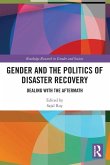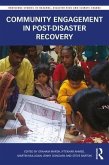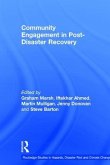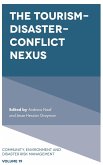The Routledge Handbook of Disaster Response and Recovery
Herausgeber: Paul, Bimal Kanti; Juran, Luke
The Routledge Handbook of Disaster Response and Recovery
Herausgeber: Paul, Bimal Kanti; Juran, Luke
- Gebundenes Buch
- Merkliste
- Auf die Merkliste
- Bewerten Bewerten
- Teilen
- Produkt teilen
- Produkterinnerung
- Produkterinnerung
The Handbook of Disaster Response and Recovery covers the two post-disaster stages of the disaster cycle and presents a comprehensive and cutting-edge overview of their many considerations.
Andere Kunden interessierten sich auch für
![The Routledge International Handbook of Social Work and Disaster Practice The Routledge International Handbook of Social Work and Disaster Practice]() The Routledge International Handbook of Social Work and Disaster Practice264,99 €
The Routledge International Handbook of Social Work and Disaster Practice264,99 €![Gender and the Politics of Disaster Recovery Gender and the Politics of Disaster Recovery]() Gender and the Politics of Disaster Recovery56,99 €
Gender and the Politics of Disaster Recovery56,99 €![Community Engagement in Post-Disaster Recovery Community Engagement in Post-Disaster Recovery]() Community Engagement in Post-Disaster Recovery56,99 €
Community Engagement in Post-Disaster Recovery56,99 €![Community Engagement in Post-Disaster Recovery Community Engagement in Post-Disaster Recovery]() Community Engagement in Post-Disaster Recovery167,99 €
Community Engagement in Post-Disaster Recovery167,99 €![People's Response to Disasters in the Philippines People's Response to Disasters in the Philippines]() J. C. GaillardPeople's Response to Disasters in the Philippines38,99 €
J. C. GaillardPeople's Response to Disasters in the Philippines38,99 €![The Tourism-Disaster-Conflict Nexus The Tourism-Disaster-Conflict Nexus]() Andreas NeefThe Tourism-Disaster-Conflict Nexus132,99 €
Andreas NeefThe Tourism-Disaster-Conflict Nexus132,99 €![People's Response to Disasters in the Philippines People's Response to Disasters in the Philippines]() J. GaillardPeople's Response to Disasters in the Philippines38,99 €
J. GaillardPeople's Response to Disasters in the Philippines38,99 €-
-
-
The Handbook of Disaster Response and Recovery covers the two post-disaster stages of the disaster cycle and presents a comprehensive and cutting-edge overview of their many considerations.
Produktdetails
- Produktdetails
- Verlag: Routledge
- Seitenzahl: 506
- Erscheinungstermin: 25. März 2025
- Englisch
- Abmessung: 250mm x 175mm x 32mm
- Gewicht: 1044g
- ISBN-13: 9781032540320
- ISBN-10: 103254032X
- Artikelnr.: 71850053
- Herstellerkennzeichnung
- Libri GmbH
- Europaallee 1
- 36244 Bad Hersfeld
- gpsr@libri.de
- Verlag: Routledge
- Seitenzahl: 506
- Erscheinungstermin: 25. März 2025
- Englisch
- Abmessung: 250mm x 175mm x 32mm
- Gewicht: 1044g
- ISBN-13: 9781032540320
- ISBN-10: 103254032X
- Artikelnr.: 71850053
- Herstellerkennzeichnung
- Libri GmbH
- Europaallee 1
- 36244 Bad Hersfeld
- gpsr@libri.de
Bimal Kanti Paul is a professor of Geography and Geospatial Sciences at Kansas State University who specializes in various aspects of environmental hazards. He has contributed to the field by integrating the social sciences with the physical sciences to address environmental concerns more holistically. Paul has compiled an outstanding publication record, including seven books on environmental hazards as single or co-author. Recently, Stanford University identified Paul among the top 2% of researchers in the world. He was also editor of the Geographical Review (2013-2015), book review editor of The Professional Geographer (2011-2012), and is a fellow of the American Association of Geographers. Luke Juran is a professor in the Department of Geography and at the Virginia Water Resources Research Center at Virginia Tech. Juran's research focuses on the human ecology of water and disaster reconstruction with an emphasis on the implementation of community-level water and sanitation systems after disasters. Juran's research investigates issues related to social vulnerability, water quality, and access to water with particular attention paid to gender and human-environment interactions. In addition to ongoing projects in India, Juran has conducted and supervised research in Bangladesh, Costa Rica, Mauritius, Mexico, Nepal, Sri Lanka, Tanzania, and the United States.
List of figures
List of tables
List of boxes
Introduction
Part I: Disaster Response
Section I: Disaster Response: Key Elements and Activities
1. Key Elements and Activities of Disaster Response
2. Search and Rescue (SAR)
3. Emergency Medical Care
4. Debris Management and Removal
Section II: Channeling Disaster Response
5. Flash Appeal as a Framework for Disaster Response
6. Post-Disaster Needs Assessments (PDNAs)
7. Emergency Relief Flows and Determinants of Disaster Aid
8. Social Networks and Emergency Response
Section III: Disaster Relief and Aid Efforts
9. Non-Governmental Organizations (NGOs) as Providers and Distributors of
Disaster Assistance
10. Participation of Domestic and Foreign Military Forces in Disaster
Relief
11. International and Domestic Diplomacy with Disaster Aid
12. Flow and Management of Disaster Relief: The Case of Bangladesh
13. Humanitarianism and Volunteerism in Disaster Response: The Case of Sikh
Volunteers during the 2022 Australia Floods
Section IV: Disaster Response Issues and Visions
14. Biases and Vulnerable Populations in Relief Distribution
15. Myths Related to Disaster Response
16. Outbreak of Epidemics during Disaster Response
17. Technology and Technological Methods in Disaster Response
Part II: Disaster Recovery
Section V: Disaster Recovery: Key Elements and Activities
18. Key Elements and Activities of Disaster Recovery
19. Disaster Recovery Cycle
20. Disaster Recovery Outcomes
21. Sustainable Disaster Recovery
Section VI: Disaster Recovery Theories and Approaches
22. Disaster Recovery Models
23. Reconfiguring the Kates-Pijawka Recovery Model for a New Era
24. Evolution of Recovery Studies and Recovery Duration
25. Social Science Methodologies in Disaster Recovery Research
Section VII: Disaster Recovery Contexts
26. The Role of Households and Communities in Disaster Response and
Recovery: The Case of the Pacific and Small Island Developing States
27. Opportunities that Arise during a Crisis: The Case of Ho Chi Minh City,
Vietnam
28. Sources and Distribution of Internal and External Funding: The Case of
Housing Reconstruction after the 2015 Nepal Earthquake
29. Recovery Among Vulnerable Populations: The Case of 'Forgotten People'
after the 2015 Nepal Earthquake
30. Computer Modeling to Inform Disaster Recovery: The Case of Hurricane
Matthew in North Carolina
Section VIII: Disaster Recovery Issues and Visions
31. Disaster Recovery and Businesses
32. Disaster Recovery and Heritage Buildings
33. Disaster Recovery and Mental Health
34. COVID-19 and Disaster Response and Recovery
Conclusions and futures
Index
List of tables
List of boxes
Introduction
Part I: Disaster Response
Section I: Disaster Response: Key Elements and Activities
1. Key Elements and Activities of Disaster Response
2. Search and Rescue (SAR)
3. Emergency Medical Care
4. Debris Management and Removal
Section II: Channeling Disaster Response
5. Flash Appeal as a Framework for Disaster Response
6. Post-Disaster Needs Assessments (PDNAs)
7. Emergency Relief Flows and Determinants of Disaster Aid
8. Social Networks and Emergency Response
Section III: Disaster Relief and Aid Efforts
9. Non-Governmental Organizations (NGOs) as Providers and Distributors of
Disaster Assistance
10. Participation of Domestic and Foreign Military Forces in Disaster
Relief
11. International and Domestic Diplomacy with Disaster Aid
12. Flow and Management of Disaster Relief: The Case of Bangladesh
13. Humanitarianism and Volunteerism in Disaster Response: The Case of Sikh
Volunteers during the 2022 Australia Floods
Section IV: Disaster Response Issues and Visions
14. Biases and Vulnerable Populations in Relief Distribution
15. Myths Related to Disaster Response
16. Outbreak of Epidemics during Disaster Response
17. Technology and Technological Methods in Disaster Response
Part II: Disaster Recovery
Section V: Disaster Recovery: Key Elements and Activities
18. Key Elements and Activities of Disaster Recovery
19. Disaster Recovery Cycle
20. Disaster Recovery Outcomes
21. Sustainable Disaster Recovery
Section VI: Disaster Recovery Theories and Approaches
22. Disaster Recovery Models
23. Reconfiguring the Kates-Pijawka Recovery Model for a New Era
24. Evolution of Recovery Studies and Recovery Duration
25. Social Science Methodologies in Disaster Recovery Research
Section VII: Disaster Recovery Contexts
26. The Role of Households and Communities in Disaster Response and
Recovery: The Case of the Pacific and Small Island Developing States
27. Opportunities that Arise during a Crisis: The Case of Ho Chi Minh City,
Vietnam
28. Sources and Distribution of Internal and External Funding: The Case of
Housing Reconstruction after the 2015 Nepal Earthquake
29. Recovery Among Vulnerable Populations: The Case of 'Forgotten People'
after the 2015 Nepal Earthquake
30. Computer Modeling to Inform Disaster Recovery: The Case of Hurricane
Matthew in North Carolina
Section VIII: Disaster Recovery Issues and Visions
31. Disaster Recovery and Businesses
32. Disaster Recovery and Heritage Buildings
33. Disaster Recovery and Mental Health
34. COVID-19 and Disaster Response and Recovery
Conclusions and futures
Index
List of figures
List of tables
List of boxes
Introduction
Part I: Disaster Response
Section I: Disaster Response: Key Elements and Activities
1. Key Elements and Activities of Disaster Response
2. Search and Rescue (SAR)
3. Emergency Medical Care
4. Debris Management and Removal
Section II: Channeling Disaster Response
5. Flash Appeal as a Framework for Disaster Response
6. Post-Disaster Needs Assessments (PDNAs)
7. Emergency Relief Flows and Determinants of Disaster Aid
8. Social Networks and Emergency Response
Section III: Disaster Relief and Aid Efforts
9. Non-Governmental Organizations (NGOs) as Providers and Distributors of
Disaster Assistance
10. Participation of Domestic and Foreign Military Forces in Disaster
Relief
11. International and Domestic Diplomacy with Disaster Aid
12. Flow and Management of Disaster Relief: The Case of Bangladesh
13. Humanitarianism and Volunteerism in Disaster Response: The Case of Sikh
Volunteers during the 2022 Australia Floods
Section IV: Disaster Response Issues and Visions
14. Biases and Vulnerable Populations in Relief Distribution
15. Myths Related to Disaster Response
16. Outbreak of Epidemics during Disaster Response
17. Technology and Technological Methods in Disaster Response
Part II: Disaster Recovery
Section V: Disaster Recovery: Key Elements and Activities
18. Key Elements and Activities of Disaster Recovery
19. Disaster Recovery Cycle
20. Disaster Recovery Outcomes
21. Sustainable Disaster Recovery
Section VI: Disaster Recovery Theories and Approaches
22. Disaster Recovery Models
23. Reconfiguring the Kates-Pijawka Recovery Model for a New Era
24. Evolution of Recovery Studies and Recovery Duration
25. Social Science Methodologies in Disaster Recovery Research
Section VII: Disaster Recovery Contexts
26. The Role of Households and Communities in Disaster Response and
Recovery: The Case of the Pacific and Small Island Developing States
27. Opportunities that Arise during a Crisis: The Case of Ho Chi Minh City,
Vietnam
28. Sources and Distribution of Internal and External Funding: The Case of
Housing Reconstruction after the 2015 Nepal Earthquake
29. Recovery Among Vulnerable Populations: The Case of 'Forgotten People'
after the 2015 Nepal Earthquake
30. Computer Modeling to Inform Disaster Recovery: The Case of Hurricane
Matthew in North Carolina
Section VIII: Disaster Recovery Issues and Visions
31. Disaster Recovery and Businesses
32. Disaster Recovery and Heritage Buildings
33. Disaster Recovery and Mental Health
34. COVID-19 and Disaster Response and Recovery
Conclusions and futures
Index
List of tables
List of boxes
Introduction
Part I: Disaster Response
Section I: Disaster Response: Key Elements and Activities
1. Key Elements and Activities of Disaster Response
2. Search and Rescue (SAR)
3. Emergency Medical Care
4. Debris Management and Removal
Section II: Channeling Disaster Response
5. Flash Appeal as a Framework for Disaster Response
6. Post-Disaster Needs Assessments (PDNAs)
7. Emergency Relief Flows and Determinants of Disaster Aid
8. Social Networks and Emergency Response
Section III: Disaster Relief and Aid Efforts
9. Non-Governmental Organizations (NGOs) as Providers and Distributors of
Disaster Assistance
10. Participation of Domestic and Foreign Military Forces in Disaster
Relief
11. International and Domestic Diplomacy with Disaster Aid
12. Flow and Management of Disaster Relief: The Case of Bangladesh
13. Humanitarianism and Volunteerism in Disaster Response: The Case of Sikh
Volunteers during the 2022 Australia Floods
Section IV: Disaster Response Issues and Visions
14. Biases and Vulnerable Populations in Relief Distribution
15. Myths Related to Disaster Response
16. Outbreak of Epidemics during Disaster Response
17. Technology and Technological Methods in Disaster Response
Part II: Disaster Recovery
Section V: Disaster Recovery: Key Elements and Activities
18. Key Elements and Activities of Disaster Recovery
19. Disaster Recovery Cycle
20. Disaster Recovery Outcomes
21. Sustainable Disaster Recovery
Section VI: Disaster Recovery Theories and Approaches
22. Disaster Recovery Models
23. Reconfiguring the Kates-Pijawka Recovery Model for a New Era
24. Evolution of Recovery Studies and Recovery Duration
25. Social Science Methodologies in Disaster Recovery Research
Section VII: Disaster Recovery Contexts
26. The Role of Households and Communities in Disaster Response and
Recovery: The Case of the Pacific and Small Island Developing States
27. Opportunities that Arise during a Crisis: The Case of Ho Chi Minh City,
Vietnam
28. Sources and Distribution of Internal and External Funding: The Case of
Housing Reconstruction after the 2015 Nepal Earthquake
29. Recovery Among Vulnerable Populations: The Case of 'Forgotten People'
after the 2015 Nepal Earthquake
30. Computer Modeling to Inform Disaster Recovery: The Case of Hurricane
Matthew in North Carolina
Section VIII: Disaster Recovery Issues and Visions
31. Disaster Recovery and Businesses
32. Disaster Recovery and Heritage Buildings
33. Disaster Recovery and Mental Health
34. COVID-19 and Disaster Response and Recovery
Conclusions and futures
Index









